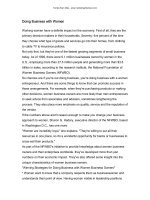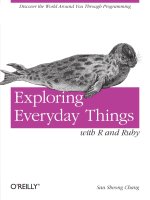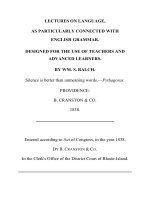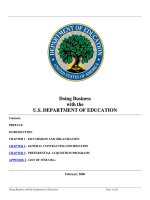doing things with language
Bạn đang xem bản rút gọn của tài liệu. Xem và tải ngay bản đầy đủ của tài liệu tại đây (725.52 KB, 32 trang )
Presented by
:
Nguyen Thi Thanh Nga
Vu Thi Hoai Van
My Phuong, Chuong,Thanh
I. Focus
II.Functions of language
1. Language is more than communication
2. Making sense of our environment
3. Language as social interaction
4. Language and social values
5. Language to exchange information
6. Learning language functions
7. Language for structuring reality
I. Focus
III.Language and Communication
1. What is communication?
2. Factors influencing communication
3. Improving our communication skills
IV. Implications for the classroom
In this chapter we focus on understanding that:
language is more than communication
Language serves a number of functions in our society
Language is the means by which we make and share meaning with
ourselves and with others
We take up and allocate social roles through languages
We use language to establish group identity
A major function of language is to structure reality, to make sense of our
world
We all possess different realities/ worlds
Communication is a transactive process and effective communication is
very important for teaching
Language is more than communication. Ex. The
ants are communicating with each other by
stopping to touch antennae
Language is more than communication
Ex 2:
Mary: It’s a lovely day, isn’t it?
John : Sure is
We use language and construct a list
of the different things that we see being
done by language users as they use
language in their daily lives.
Language is more than communication
•
The use of language when we speak or write
involve action that can be seen. Our action are
less obvious when we read or listen to someone
else speaking.
•
Meaning and shared meaning are at the heart of
what we do with language
•
One distinction that can be drawn is the one
between language as action- language directed
to others- and language as reflection, as thinking
Making sense of our environment
Please find herewith the following utterances of three boys:
•
Simon spoke first “Like candles. Candle bushes. Candle buds”
•
Ralph said “You couldn’t fight them, they just look like candles”
•
Jack said contemptuously “Green candles, we can’t eat them”
How are the boys
using language?
for what functions
is language
being used?
Making sense of our environment
Language is used for a range of purposes.
LANGUAGE
Explain or instruct
Question
Praise and
encourage
…etc.
Promote social
interaction
Control or direct
behaviour
Language as social interaction
•
Language gives us ways of addressing each other.
Ex: parents are called by their first name. However, sometimes
this is regarded as outright impertinence
Therefore, we create a range of titles to identify or address others
whose rank of authority needs to be acknowledged
•
Differences in the social position of women by providing
“Mister” as the one respectful title for adult males
Miss unmarried woman
Mrs married woman
Finally, Ms was proposed as a general term of respectful address
for all women regardless of their marital status
Language as social interaction
•
Distinguish the difference between two French person pronouns
ex: Où est-ce que tu vas? Or Où est-ce que vous allez?
Tu and Vous number, tu singular form
Vous the plural form
Moreover, the two words serve another purpose by indicating the
difference in status and intimacy between the speaker and the
listener.
Vous => respectful while tu => intimate
•
The another example of the way we use language to negotiate social
interaction
Ex: How are you ?
Hi
Good morning
“Good morning” can be said to someone regardless of whether it is in
fact a good morning. “How are you?” doesn’t seem to be a question
at all
Language and social values
•
Gossip is the means by which people keep in touch with the
values of their associates and community
•
When we participate in such a discussion we confirm or
modify our own values and we place them into a context of
other people’s values
•
We gossip to discover what others think and to find ways of
positioning our own thinking on the same issues
•
To some extent, jokes and stories do the same thing as gossip
•
Telling and listening to jokes is not just an amusing way of
passing time : it is an important way by which groups can
maintain a shared set of values
Stories the sets of values => a group culture
•
Changes in literary taste are not merely changes in fashion
but are born reflections of and shapes of the values and
attitudes of the culture from which they grow.
Language to exchange
information
Exchange
information
Ask for
information from
each other
Assert
propositions
Deny
propositions
Cooperative Principle
by Grice (1975)
Quantity Relation Quality Manner
Provide as much
information as the
exchange requires
Be relevant Try to say what
is true
- Be clear
- Be brief
- Be orderly
Don’t provide
more information
than the exchange
requires
- Don’t say what
you believe to be
false
- Don’t say things
you don’t have
supporting
evidence for
- Avoid obscurity
- Avoid ambiguity
Language to exchange
information
The listener, or reader, has an important
co-operative role to play in business
of sharing information.
Tend to break each of Grice’s rules.
Language to exchange
information
•
A: Do you think Jack will pass the exam?
B: Huh, the sun rises in the West.
Qual ity
Quality
Language for structuring reality
•
Through language we learn to make meaning,
to make sense of experiences.
•
Language used in the process of labeling our
experiences enables us to simplify and
generalize our experiences to facilitate
communication.
Language to exchange
information
•
Lisa & Jenny are in the restaurant:
Lisa : Wow, your dress looks fashionable.
Jenny: What would you like for the dessert?
Rela
tion
Relation
Learning language
functions
Halliday (1973) classified the speech
functions into seven.
Smith (1983) expended the functions to
ten.
Purposes of writing & their forms
LANGUAGE AND
COMMUNICATION
Questions:
1. What is communication?
2. What are some factors influencing
communication?
3. What processes are involved in
communication?
4. How can we improve our communication?
LANGUAGE AND
COMMUNICATION
1. What is communication?
Communication can be defined as the
use of language where more than one
person is involved in constructing
meaning.
System of signs
•
Another way of thinking about language
and communication is as a system of
signs
•
The study of the construction of signs
which are used to convey meaning is
called SEMIOTICS
System of signs
signs
ICON
INDEX
SYMBOL
LONELINESSCOLD
A sign which resembles the
object it signifies
A sign that is causally connected
to the object it signifies
A sign that arbitrarily and
conventionally related to it referent
or object
Factors influencing communication:
familial
regional
personal
social
national
Factors influencing communication:
Nested hierarchy of language-communication determinant
by M.H.Cameron and M.T.Saweders









